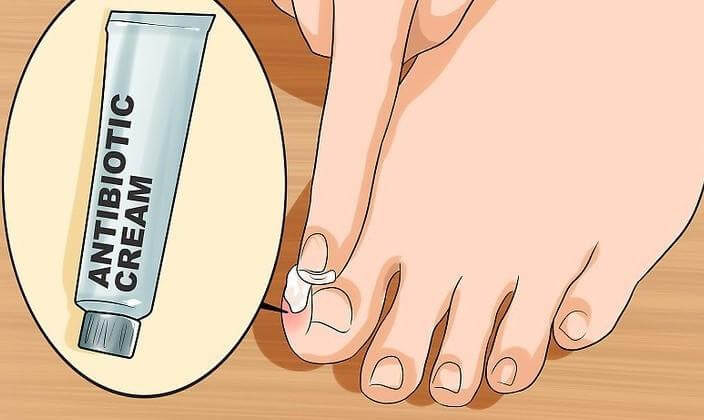Innovative Non-Toxic Skin Healing Solutions

Toenail fungus, toenail pain, toenail infection, ingrown nail…sound familiar? It should. Nearly half of all foot-related complaints to the doctor are ingrown toenail pain. Nothing to be embarrassed about, right? Unless if your sore ingrown toenails are looking scruffy, jagged, discolored, swollen and painful. The good news is ingrown toenail otherwise known as onychocryptosis is very treatable. The bad news is if left untreated or improperly treated, it can lead to more ominous conditions such as toenail fungus. And contrary to ingrown nails, fungal infections of the toenails are notorious for being resistant to treatment. Here we explain the various effective techniques to treat ingrown toenail including use of our doctor recommended Post-Traumatic Response Gel with MatrX BTM.
Ingrown toenails happen when the corner or side of the toenail grows into the soft flesh next to it. The shape and texture of the nail, the degree of pressure shoes exert, and genetic factors play a role in development of ingrown toenails. At times, the ingrown nail breaks through the skin’s barrier and attracts inflammatory cells, and opens the way to pathogens, such as fungi and bacteria. The soft fleshy part of the toe then becomes inflamed, irritated, painful and unsightly. Men are more likely to develop this problem, however, women take it more personally as it just doesn’t look good in open toed shoe-ware. There are many remedies to lift the edge of the nail thus relieving pressure against the flesh, such as dental floss or cotton wisp. Have a professional shape the nail with proper trimmers, smooth the edges, and gently remove excess skin and debris from the corners. Although it may be tempting, do not attempt to do these procedures at home. Often times, a novice hand will inflict more harm to the nail bed and potentially introduce pathogens. Indeed, infections are more common in the setting of ingrown nails, and once they set in, your problems become magnified. At home remedies are foot soaks and wearing proper shoes. Apply Post-Traumatic Response Gel with MatrX B twice daily as an ingrown nail treatment to help with pain and inflammation. The naturally occurring flavonoids and carotenoids provide the necessary nutrients, antioxidants, and anti-inflammatories needed to maximize the body’s natural healing response. The gel reduces pain, swelling, and inflammation and helps heal the condition of excess skin growth and pain. It also repairs the affected surrounding skin preventing further damage and fungal or bacterial occurrence.
Look for signs of bacterial infection, such as worsening pain, redness, inflammation, and swelling. These types of infections should be addressed immediately with your podiatrist or physician. Fungal toenail infections (onychomycosis) are also common among persons with ingrown toenails, diabetics, older individuals, if there are cracks in the nail or cuts in the skin around it. Because fungi thrive in moist and warm places, our toenails are the perfect environment for them to overpopulate making it more difficult to treat the area. Unfortunately, onychomycosis is much harder to treat and often require topical anti-fungals, frequent trimmings by a podiatrist, and oral anti-fungal medications for more resistant cases. Laser light therapy has mixed results, and likely not worth the high expense. Avoid use of topical antibiotics such as Neosporin to treat fungal infections as they also kill the helpful microbiome that protect the body’s over all immune system.
Ingrown toenail pain is a common and disturbing condition, but now you have found the right solution to cure it once and for all by using Post-Traumatic Response Gel with MatrX B and forget about your toenail pain for good.
Grice, E. A., & Segre, J. A. (2011). The skin microbiome. Nature Reviews Microbiology, 9(4), 244-253. doi:10.1038/nrmicro2537
Shahbazian, J., Hartzell, T., Pandey, A., & Azari, K. (2012). Allergic Dermatitis Due to Topical Antibiotics. Western Journal of Emergency Medicine, 13(4), 380-382. doi:10.5811/westjem.2011.9.6851
Shirwaikar, A., Thomas, T., Shirwaikar, A., Lobo, R., & Prabhu, K. (2008). Treatment of onychomycosis: An update. Indian Journal of Pharmaceutical Sciences, 70(6), 710. doi:10.4103/0250-474x.49088
Seaside Medical Technologies. (n.d.). Treating Ingrown Toenail Pain With A Non-Toxic Gel. Retrieved from https://www.seasidemedicaltech.com/blogs/news/treating-ingrown-toenail-pain-with-a-non-toxic-gel
Seaside Medical Technologies. (n.d.). Is it time to ditch the Neosporin? Retrieved from https://www.seasidemedicaltech.com/blogs/news/is-it-time-to-ditch-the-neosporin
Comments will be approved before showing up.